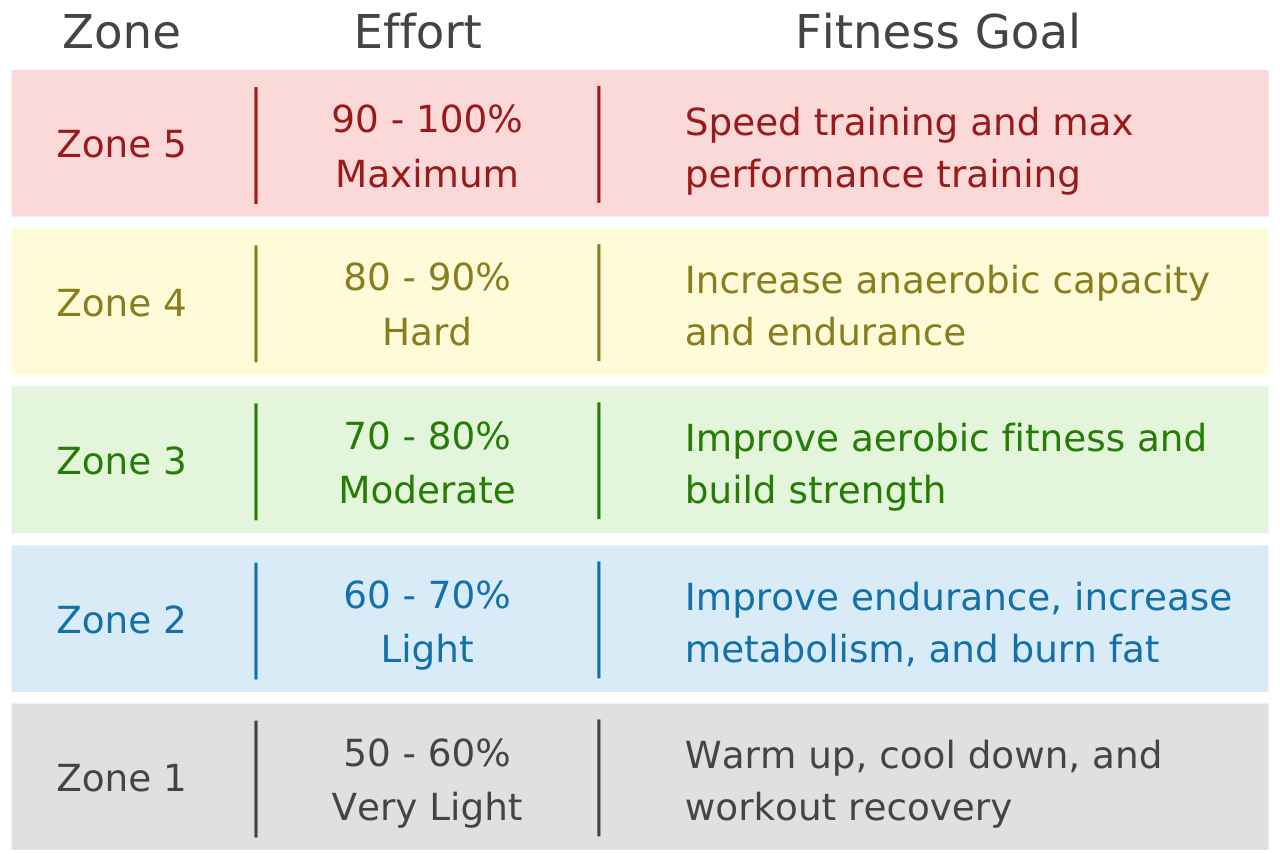Target Heart Rate Calculator
Calculate the optimal target heart rate for each zone and for various fitness goals given your age.
Your Target Heart Rate:
| ZONE | EFFORT | TARGET HR |
|---|---|---|
| 1 | very light (warm up) | |
| 2 | light (fat burn) | |
| 3 | moderate (aerobic) | |
| 4 | hard (anaerobic) | |
| 5 | maximum (speed) |
Max Heart Rate
Target Heart Rate Using CDC Recommendations[1]
| Moderate Intensity: | |
| Vigorous Intensity: |
On this page:
How to Calculate Target Heart Rate
It can be tough to figure out if you are working out to your maximum potential during exercise. Fitness and health professionals advocate achieving a specific heart rate or reaching an optimal heart rate in order to make the most out of your workouts – and subsequently, you’ll be able to gauge your workout intensity over time.
Knowing what your heart rate is while you are exercising has several benefits.
For one, this allows you to individualize your workouts to match your current level of fitness. This is also important for people with underlying medical issues to ensure that they get the most out of each exercise session without pushing beyond their current capabilities.
Secondly, by knowing and tracking your heart rate, you can assess your cardio-respiratory fitness as it improves over time. As your cardio-respiratory fitness improves over time, your heart becomes more efficient at pumping oxygenated blood through your body.
The result of this is less drastic spikes in your heart rate during the same levels of activity and an increased capacity to work at higher levels of intensity.
In addition, working out in different heart rate zones has its own specific benefits. For example, lower heart rate zones for moderate-level or steady-state workouts utilize the oxidative energy system and burns carbohydrates and fats as its main source, while more intense anaerobic workouts utilize the phosphagen system and are designed to train your body for power and speed while boosting metabolism.
Many athletes dedicate workouts to training in the zone 2 range for extended periods of time to improve their aerobic capacity.
Maximum Heart Rate
The first step to determining your target heart rate is to estimate what your maximum heart rate is. The most commonly used formula for this is based on the CDC calculation of 220 minus your age in years.
max heart rate = 220 – age in years
As you get older, your maximum heart rate slowly declines.
For example, the maximum heart rate for a 20-year-old would be 200 beats per minute (bpm), while the maximum heart rate for a 40-year-old would only be 180 bpm.
20-year-old max heart rate = 220 – 20 = 200
40-year-old max heart rate = 220 – 40 = 180
Karvonen Formula
The Karvonen formula, also known as the heart rate reserve (HRV) formula, is another method of determining what your target heart rate should be at a given workout intensity.
This formula is a more accurate way of determining a target heart rate as it is more dynamic, utilizing your maximum and resting heart rates along with the desired training intensity in order to produce your target heart rate.
target heart rate = [(max HR – resting HR) × %intensity] + resting HR
The max HR will still be measured indirectly, utilizing the formula discussed above (220 – age). While your resting HR will change over time, decreasing as your conditioning improves.
To find your resting heart rate, it is recommended that you measure your HR first thing in the morning before getting out of bed, as this will be at or near its lowest. Plugging your heart rates into the formula above and selecting your desired intensity (for which you may use the table below depending on your goals) will provide you with a specific target heart rate.
You may also use a range of intensities, utilizing the formula more than once, in order to produce a Heart Rate Range that you may strive to stay in during your workout.
This formula requires slightly more arithmetic, however produces a target heart rate that is more specific to one’s current fitness levels. Often used in Physical Therapy or Cardiac Rehab, this formula is also widely used in the fitness world.
Heart Rate Zones

Once you determine your maximum heart rate, the target heart rate zones are then based on a percentage of this number.
According to the Physical Activity Guidelines Advisory Committee Report, moderate-intensity target heart rate is 64-76% of maximum heart rate, while during vigorous-intensity exercise, the target heart rate is around 77-93% of max.[2]
Target heart rate zones can be broken down into five different zones based on perceived exertion and the goals of the workout.
| Zone | Target Heart Rate (% of Max Heart Rate) |
|---|---|
| 1 (Very easy/warm up/cool down) | 50-60% |
| 2 (Easy-Moderate) | 60-70% |
| 3 (Moderate/Aerobic) | 70-80% |
| 4 (Hard/Anaerobic) | 80-90% |
| 5 (Very Hard/Neuromuscular) | 90-100% |
The target heart rate formula is based on these percentages of maximum heart rate.
For example, for a 40-year-old, their maximum heart rate would be 180 beats per minute. If they wanted to work out in the aerobic zone, they would target 70-80% of their max heart rate, which would be 126-144 beats per minute.
180 × 0.7 = 126 bpm
180 × 0.8 = 144 bpm
On the other hand, if this same person were performing a high-intensity interval workout, they would need to target a heart rate in the hard, or anaerobic zone for these intervals. Their target heart rate would then be 144-162 beats per minute.
180 × 0.8 = 144 bpm
180 × 0.9 = 162 bpm
Resting Heart Rate
Resting heart rate is just what you might think it would be. It’s the number of times your heart beats per minute when you are just sitting at rest.
The best time of day to check your resting heart rate is first thing in the morning before you get out of bed. At this point, you are well-rested and have no added stress from the day, which means your heart rate should be at its lowest at this time.
Resting heart rates vary between individuals and will be affected by numerous factors such as age, stress, hormones, medications, current fitness level, and any health conditions.
According to the American Heart Association, a normal resting heart rate is generally considered to be around 60-100 beats per minute.[3] However, it can be as low as 40-50 beats per minute in some very conditioned athletes.
While a low resting heart rate can be a sign of overall fitness, certain health conditions, such as hypothyroidism or primary heart block, can cause a low heart rate, which is also known as bradycardia.
Therefore, if you have symptoms such as dizziness, fatigue, or lightheadedness associated with a low heart rate, you should discuss this with your doctor.
Research has also shown that a higher resting heart rate is linked with lower physical fitness and other cardiovascular risk factors such as high blood pressure.[4]
Heart Rate During and After Exercise
As is expected, the higher the intensity of exercise, the more your heart rate will increase. The ability to achieve and tolerate a higher heart rate is based on several factors, as discussed above.
You can also tailor your workouts to a target heart rate based on your specific fitness goals. For instance, if you have an easier workout day scheduled, you may want to stay in a heart rate zone where your body burns more fat for energy.
To achieve this, you would target a heart rate around 60-70% of your max. Try adjusting your pace to stay in this zone.
In addition, how quickly your heart rate returns to normal after exercise, known as heart rate recovery (HRR), is a good predictor of overall fitness. Your heart rate’s ability to recover after physical activity is associated with a reduced risk of death.
To calculate your heart rate recovery, you will check your heart rate immediately following exercise and subtract from it your heart rate following one minute of rest.
HRR = immediate post-workout heart rate – (heart rate following 60 seconds of rest)
Heart rate recovery is normally calculated at 1, 2, or 3-minute intervals, with the 1-minute HRR being the most commonly used. For example, if your heart rate is 160bpm when you finish working out, and 1 minute later it drops to 140bpm, your HRR is 20bpm. HRR can vary from person to person and from day to day, affected by factors such as age, stress, nutrition, and hormones.
A study published in the New England Journal of Medicine looking at roughly 2500 adults over a 6-year period observed that the median value for HRR was 17bpm.
Heart rate recovery is an indication of the relationship between the sympathetic and parasympathetic nervous systems. Research shows that HRR is a result of how fast your autonomic nervous system can “shift” from the sympathetic system back to the parasympathetic system.
HRR is correlated with one’s overall cardiovascular health, and poor HRR is associated with an increased risk of cardiac events and mortality.
In fact, a study from the Journal of the American College of Cardiology noted that heart rate recovery after exercise occurs much quicker in well-trained athletes, but is slower to come back to normal in patients with underlying heart conditions.[5]
Research has also found that a slow decrease in heart rate during the first minute after exercise can be a predictor of overall mortality.[6]
With a well-designed and individualized training program, you can improve your overall fitness to lower your resting heart rate and the ability of your body to recover after exercise.
Improve Your Fitness With Target Heart Rate Zones
When you aren’t sure how hard to push yourself during exercise, calculating your target heart rate zones is a great way to get the most out of your workouts. This allows you to challenge yourself if your heart rate is too low, or back off if you are going above what your target heart rate should be.
Plus, you can improve your overall fitness by increasing your heart’s efficiency, visualized as a lower resting heart rate and leading to a decrease in the risk of chronic health issues.
References
- Centers for Disease Control and Prevention, Target Heart Rate and Estimated Maximum Heart Rate, https://www.cdc.gov/physicalactivity/basics/measuring/heartrate.htm
- Physical Activity Guidelines Advisory Committee - U.S. Dept of Health and Human Services, Physical Activity Guidelines Advisory Committee Report, 2008, https://health.gov/sites/default/files/2019-10/CommitteeReport_7.pdf
- American Heart Association, All About Heart Rate (Pulse), https://www.heart.org/en/health-topics/high-blood-pressure/the-facts-about-high-blood-pressure/all-about-heart-rate-pulse
- Jensen MT, Suadicani P, Hein HO, et al, Elevated resting heart rate, physical fitness and all-cause mortality: a 16-year follow-up in the Copenhagen Male Study, Heart, 99, 882-887. https://heart.bmj.com/content/99/12/882.full?sid=90e3623c-1250-4b94-928c-0a8f95c5b36b
- Imai, K., Sato, H., Hori, M., Kusuoka, H., Ozaki, H., Yokoyama, H., et al, Vagally mediated heart rate recovery after exercise is accelerated in athletes but blunted in patients with chronic heart failure, Journal of the American College of Cardiology, 1994, 24(6), 1529-1535. https://www.jacc.org/doi/abs/10.1016/0735-1097(94)90150-3
- Cole, C. R., Blackstone, E. H., Pashkow, F. J., Snader, C. E., & Lauer, M. S., Heart-rate recovery immediately after exercise as a predictor of mortality, New England Journal of Medicine, 1999, 341(18), 1351-1357. https://www.nejm.org/doi/10.1056/NEJM199910283411804



